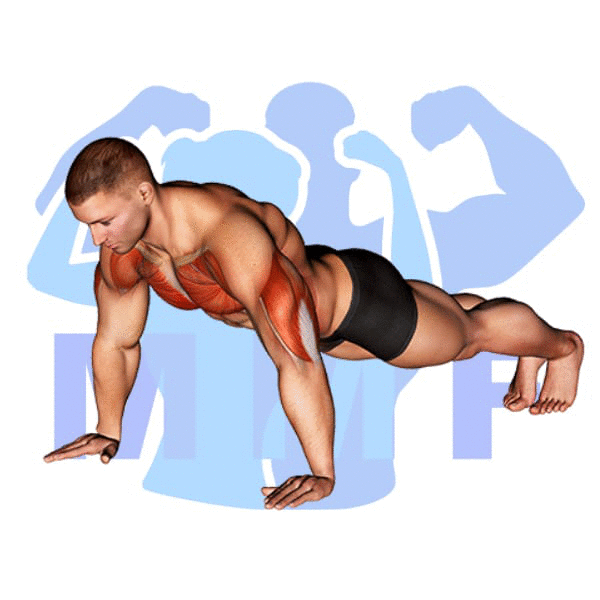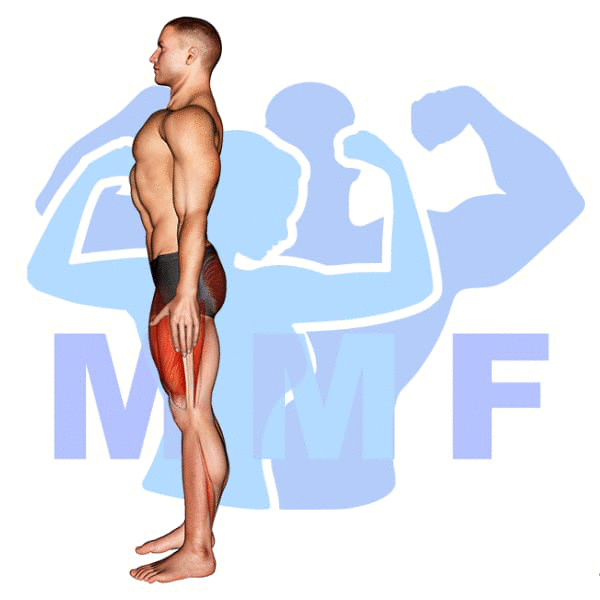Push Up, of course, are a tremendous exercise to firm your chest. Are you searching to use great form and tone up your Pectoralis Major? You should start using our how-to guide to help you get going straight away.
Push Up Summary
- Primary Muscles: Pectoralis Major – Sternal
- Secondary Muscles: Deltoid – Anterior, Pectoralis Major – Clavicular, and Triceps Brachii
- Equipment: Body Weight
- Mechanics Type: Compound
- Force: Push
- Utility: Basic or Auxiliary

Push Up Instructions
- Lie prone on the floor with your hands slightly wider than shoulder width.
- Raise your body up off the floor by extending your arms with your body straight. Keep your body straight by flexing your core and lower your body to the floor by bending your arms.
- Again, push your body up fully and extend your arms.
- Continue your Push Up for a full set or a hundred, “why not set some goals?”
Video Tutorial
Push Up Muscles
Target (Agonist)
- Pectoralis Major – Sternal
Synergists
- Deltoid – Anterior
- Pectoralis Major – Clavicular
- Triceps Brachii
Dynamic Stabilizers
- Biceps Brachii – Short Head
Stabilizers
- Erector Spinae
- Levator Scapulae
- Trapezius – Middle
- Trapezius – Upper
Antagonist Stabilizers
- Erector Spinae

Benefits of Push Up
The pectoralis major – sternal muscle is a large chest muscle that is heavily engaged when performing a push up. Push ups are an excellent exercise for strengthening the chest and arms, as they involve pushing the body away from the ground. The push up exercise is also a great way to build endurance and overall strength. When performing push ups, the pectoralis major – sternal muscle is activated which helps to strengthen the chest and increase its size. In addition, push ups also help improve posture by strengthening the muscles in the upper back and core. This makes them an excellent choice for those looking to improve their overall physical fitness.
Tips for Performing Push Up
You’ve come at the right location if you desire to advance your capability to conduct push up. Using these suggestions can allow you to maximize the advantages of this effective workout. You can strengthen your chest muscles, and even lower your chances of experiencing an injury. Let’s begin and take a look at how these tips will benefit you.
- Make sure your form is correct: Set your hands slightly wider than your shoulders and keep your back straight. This will ensure you are getting the most out of the exercise and prevent injury.
- Take it slow: Pushing too hard can cause injury, so take it slow and concentrate on the form. This will ensure you are getting the most benefit from the exercise.
- Get creative: Don’t be afraid to mix up your push-up routine. Try doing them on a bench or box for a different angle, or vary the speed for an extra challenge. This will help you get the most out of your bodyweight exercise and keep you motivated to work out.
Benefits and Tips Video
Frequent Mistakes To Avoid
When conducting push up, avoiding typical mistakes can be the difference to achieving optimal results and avoiding injury. From improper form to not keeping your core engaged, these mistakes can reduce the productiveness of the exercise and can even put you at risk for injury. But relax, it’s not as challenging as it might seem. By knowing the errors to avoid and taking the right actions, you can execute the activity securely and effectively. Let’s start by staying away from these typical mistakes and add this exercise to your training regimen.
- Doing Push Ups with incorrect form: Doing Push Ups with incorrect form can lead to injury and not provide the desired results.
- Not having enough variation: Not having enough variation in your Push Up routine can lead to plateauing and not being able to continue making progress.
- Not doing enough reps: Not doing enough reps can also lead to plateauing, as your body needs to be challenged in order to continue to improve.
Variations and Complementary Exercises
Push Up is an effective exercise for strengthening your chest, triceps, and shoulders. However, if you’re looking to add variety to your workout or if you want to target different muscles, there are many variations, complementary, and alternative exercises that can help you achieve the same results as a traditional Push Up.
Push Up On Grips

Push Up On Grips is a complementary exercise to the traditional Push Up. It works the same muscles as a regular Push Up, but with an added challenge. The additional grip on the handles increases resistance and engages more of the muscles in the arms and shoulders, while also helping to improve balance and stability. This exercise is perfect for athletes or bodybuilders looking to increase muscle mass or strength. By changing up the type of push up performed, you can continue to challenge yourself and improve your overall fitness.
Push-Ups With Bands

Push-Ups With Bands is a great complementary or alternative exercise for the traditional Push Up. This exercise adds a new level of challenge by using resistance bands to increase the difficulty of the exercise. The resistance bands allow for a greater range of motion, which can help to target different muscle groups and build strength in the arms and chest. The exercise also helps to improve balance, coordination, and core stability. Push-Ups With Bands is a great way to increase the intensity of the traditional Push Up and take your workout to the next level.
Superman Push Up

The Superman Push Up is a great alternative or complementary exercise to the classic Push Up. This exercise involves starting in a traditional Push Up position, then lifting both arms and legs off the ground simultaneously. This exercise engages the core muscles more than the traditional Push Up, while still providing an effective upper body workout. It can be used as an alternative to the traditional Push Up when looking for a more intense workout, or as a complementary exercise when looking to add variety to your routine.
Check Out These Top Bodyweight Exercises
Wide Push Up

Wide Push Up is a great alternative or complementary exercise for the traditional Push Up. This exercise involves the same basic movement of a Push Up but with a wider hand placement. This helps to target the chest muscles more effectively and can also provide a greater range of motion. When done correctly, Wide Push Ups can help to improve shoulder stability and strength, as well as overall upper body strength. Additionally, this exercise can help to increase core stability and improve posture.
Decline Push Up

Decline Push Up is a great alternative or complementary exercise for those looking to increase the difficulty of the traditional Push Up. This exercise involves pushing up from an elevated platform, such as a bench, so that your body is at an incline. This increases the level of difficulty and makes the exercise more intense. Decline Push Up targets the same muscle groups as traditional Push Up, but in a more challenging way. It is also a great way to target the lower chest and triceps muscles, which are often neglected with regular Push Up.
Diamond Push Up

The Diamond Push Up is a great complementary or alternative exercise for the traditional Push Up. It involves the same basic movement, but the hands are placed in a diamond shape, which requires greater stability and strength in the chest, shoulders and triceps. This variation of the Push Up can help to target different muscles and increase the intensity of the exercise. In addition, it can be beneficial for those who cannot perform a full Push Up due to lack of strength or flexibility.
Opposing Complementary Exercises
To complete a full workout, it is important to include exercises that work the opposite muscles as the exercise Push Up. This will help to create a balanced strength and tone in the body, and prevent any muscle imbalances. The following exercises can be used to complement the Push Up and work the opposing muscle groups.
Dumbbell Chest Supported Row

The Dumbbell Chest Supported Row is an excellent exercise to complement the Push Up. It works the opposing muscle group by targeting the back muscles instead of the chest muscles used in the Push Up. By targeting the back muscles, the Dumbbell Chest Supported Row strengthens the muscles that are weaker than those used in the Push Up and helps create a balanced upper body strength. This exercise also increases core stability as you have to maintain a neutral spine throughout the exercise. The Dumbbell Chest Supported Row can help improve posture and overall upper body strength while also complementing the Push Up.
Dumbbell Rear Deltoid Raise

The Dumbbell Rear Deltoid Raise is a great exercise to complement the Push Up, as it works the opposing muscle group. This exercise targets the rear deltoids, which are the muscles located in the back of the shoulder. When doing this exercise, the weight is held at the sides with an overhand grip and then raised up to shoulder level. This exercise strengthens the back of the shoulders, which helps to keep them in balance with the front of the shoulders worked in the Push Up. The combination of these two exercises helps create a well-rounded shoulder workout.
EZ Bar Reverse Grip Bent Over Row

The EZ Bar Reverse Grip Bent Over Row is a great complement to the Push Up exercise. It works the opposing muscle group by targeting the back muscles. By strengthening the back muscles, it helps to create a balance between the opposing muscle groups, allowing for better form and posture when performing the Push Up. This exercise also helps to improve the stability of the shoulder girdle, which can help to reduce shoulder pain caused by poor form during Push Ups.
Recap
Push-ups are an excellent exercise for anyone who wants to get fit. They work a variety of muscles, they’re easy to do, and they provide great benefits. Just be sure to pay attention to the correct form so that you can get the most out of your push-up. Now that you know all about the push-up, why not give it a try? Make sure to check out our other fitness articles for more great tips and information on getting into shape!
References: Wikipedia | ExRx.net | PubMed.gov




